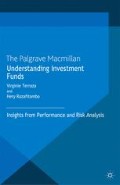Abstract
The present chapter contributes to two strains of portfolio optimization literature. The first is conditioned portfolio optimization, which discusses the mathematically correct treatment of information external to the investment assets themselves within what is otherwise a classical portfolio optimization context. The second is portfolio optimization involving higher moments of returns, which attempts to optimize for expected levels of portfolio returns moments beyond mean and variance. The optimal control formulation of conditioned portfolio problems introduced in Boissaux and Schiltz (2010) allows for generic numerical solution methods to be applied in the context of conditioned optimization if single signal series are used, and was applied to obtain constrained-weight solutions to the basic conditioned mean-variance problem in Boissaux and Schiltz (2011). In this chapter, the approach is applied to the higher-moment problem context. We formulate and backtest two constrained-weight higher-moment problem variants which avoid non-convex objective functions. In both cases, the use of conditioning information significantly improves observed strategy performance with respect to all metrics optimized by each problem formulation. We also briefly discuss and give results for the full four-moment problem using quartic polynomial utility functions, and find that results provide evidence that the full problem can be worked in practice even though its potentially non-convex objective function may cause numerical issues.
Access this chapter
Tax calculation will be finalised at checkout
Purchases are for personal use only
Preview
Unable to display preview. Download preview PDF.
References
Athayde G. and R. Flores (2001), “Finding a maximum skewness portfolio”, Computing in Economics and Finance, Society for Computational Economics, April 2001.
Athayde G. and R. Flores (2001), “Incorporating skewness and kurtosis in portfolio optimization: a multidimensional efficient set”, In Advances in Portfolio Construction and Implementation, pages 243–257. Butterworth-Heinemann, Boston, EUA, 2003.
Basu D., Hung C-H., Oomen R. C. and A. Stremme (2006), “When to Pick the Losers: Do Sentiment Indicators Improve Dynamic Asset Allocation?”, SSRN eLibrary.
Basu D., Oomen R. C. and A. Stremme (2006), “Exploiting the Informational Content of the Linkages between Spot and Derivatives Markets?, Warwick Business School Working Paper Series.
Betts J. T. (2001), “Practical methods for optimal control and estimation using nonlinear programming”, volume 19 of Advances in Design and Control, Society for Industrial and Applied Mathematics (SIAM), Philadelphia, PA, first edition. ISBN 0–89871–488–5.
Boissaux M. and J. Schiltz (2010), “An optimal control approach to portfolio optimization with conditioning information”, Luxembourg School of Finance Working Paper 10–09, Luxembourg School of Finance.
Boissaux M. and J. Schiltz (2011), “Practical weight-constrained conditioned portfolio optimization using risk aversion indicator signals”, Luxembourg School of Finance Working Paper 11–12, Luxembourg School of Finance.
Byrd R. H., Hribar M. E. and J. Nocedal (1999), “An interior point algorithm for large-scale nonlinear programming”, SIAMJ. Optim., 9(4):877–900. ISSN 1052–6234. Dedicated to John E. Dennis, Jr., on his 60th birthday.
Chiang I-H. E. (2008), “Modern Portfolio Management with Conditioning Information”. SSRN eLibrary.
Davies R. J., Kat H. M. and S. Lu (2003), “Fund of hedge funds portfolio selection: A multiple-objective approach”, City University Working Paper, City University London.
De Giorgi E. (2002), “A note on portfolio selection under various risk measures”, IEW — Working Papers iewwp122, Institute for Empirical Research in Economics — University of Zurich.
Ferson, W. E. and A. F. Siegel (2001), “The efficient use of conditioning information in portfolios”, The Journal of Finance, 56(3):967–982, ISSN 00221082.
Hansen L. P. and S. F. Richard (1987), “The role of conditioning information in deducing testable restrictions implied by dynamic asset pricing models”, Econometrica, 55(3):587–613. ISSN 0012–9682.
Jondeau E. and M. Rockinger (2006), “Optimal portfolio allocation under higher moments”, European Financial Management, 12(1):29–55.
Jurczenko E. and B. Maillet (2006), “Theoretical foundations of asset allocations and pricing models with higher-order moments”, In Multi-moment Asset Allocation and Pricing Models, pages 1–36. John Wiley and Sons.
Kendall M. G. (1945), The Advanced Theory of Statistics, Volume I, 2nd ed. Charles Griffin & Company Limited, 42 Drury Lane, London, W.C.2.
Kimball M. S. (1990), “Precautionary saving in the small and in the large”, Econometrica, January, 58(1): 53–73.
Kimball M. S. (1991), “Precautionary motives for holding assets”, Working Paper 3586, National Bureau of Economic Research, January 1991.
Lai K. K., Yu L. and Wang S (2006), “Mean-variance-skewness-kurtosis-based portfolio optimization”, Computer and Computational Sciences, International MultiSymposiums on, 2:292–297.
Lai T-Y (1991), “Portfolio selection with skewness: a multiple-objective approach”, Review of Quantitative Finance and Accounting, 1:293–305. ISSN 0924–865X.10.1007/BF02408382.
Luo J., Saks P., and S. Satchell (2009), “Implementing risk appetite in the management of currency portfolios”, Journal of Asset Management, 9:380–397(18).
Muller S. M. and M. Machina (1987), “Moment preferences and polynomial utility”, Economics Letters, 23(4):349–353.
Pézier J. and A. White (2006), “The relative merits of investable hedge fund indices and of funds of hedge funds in optimal passive portfolios”, ICMA Centre Discussion Papers in Finance icma-dp2006–10, Henley Business School, Reading University.
Rama Cont (2001), “Empirical properties of asset returns: stylized facts and statistical issues. Quantitative Finance, 1:223–236.
Rockafellar R. T. and S. Uryasev (2000), “Optimization of conditional value-at-risk”, Journal of Risk, 2:21–41.
Stacey J. (2008), “Multi-dimensional risk and mean-kurtosis portfolio optimization”, Journal of Financial Management and Analysis, Vol. 21, No. 2, December.
von Neumann J. and O. Morgenstern (1953), Theory of Games and Economic Behavior, Princeton University Press, Princeton, N.J., third edition. ISBN 0–691–00362–9. 129–160
Editor information
Editors and Affiliations
Copyright information
© 2013 Marc Boissaux and Jang Schiltz
About this chapter
Cite this chapter
Boissaux, M., Schiltz, J. (2013). Conditioned Higher-Moment Portfolio: Optimization Using Optimal Control. In: Terraza, V., Razafitombo, H. (eds) Understanding Investment Funds. Palgrave Macmillan, London. https://doi.org/10.1057/9781137273611_6
Download citation
DOI: https://doi.org/10.1057/9781137273611_6
Publisher Name: Palgrave Macmillan, London
Print ISBN: 978-1-349-44533-2
Online ISBN: 978-1-137-27361-1
eBook Packages: Palgrave Economics & Finance CollectionEconomics and Finance (R0)

